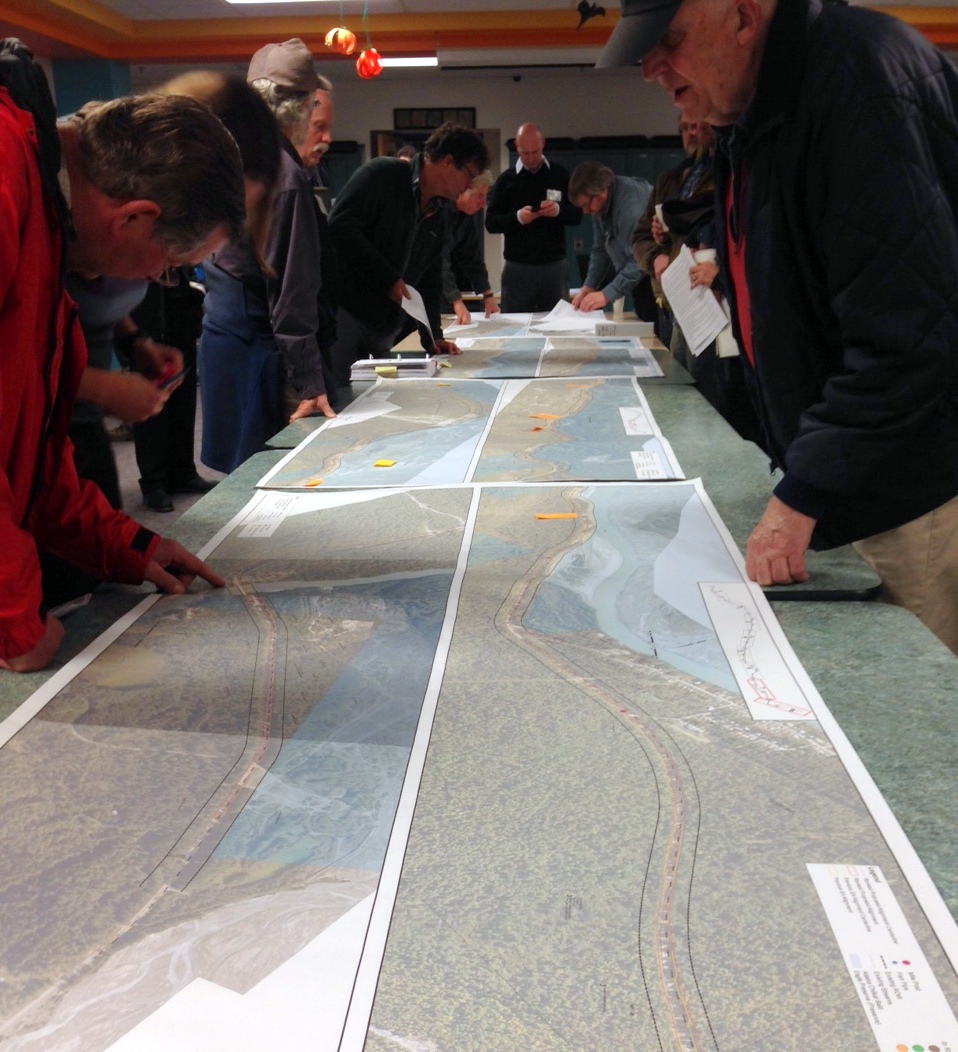
Haines residents look at a map of the Haines Highway at a workshop Wednesday evening. (Jillian Rogers)
Officials from the Department of Transportation and Public Facilities, and the Federal Highway Administration were on hand last week in Haines with big maps and glossy posters to talk to locals about the new Haines Highway plan. The revised draft environmental assessment addresses many concerns brought forth in the last comment period. But for some, it’s still not enough. KHNS’s Jillian Rogers attended the workshop and hearing at the Haines High School on Wednesday.
The official public hearing slated to take up much of the evening was a little anticlimactic. It took longer for the facilitator to explain the rules to the group than it did for the five or so people to state their piece on the new plan for upgrades to the highway. Those who did comment were mostly in favor.
“I read the revised EA and am pleased with the comprises and modifications that were done,” Tom Andriesen said in his testimony. “It looks like a good project, and I’d like this project move forward as fast as possible. Thank you.”
The proposed highway construction would widen and straighten the road from Mile 3.5 to 25.3. Representatives from the DOT and federal highways were armed with plenty of written information, maps and diagrams to inform the public of potential changes made to the project design.
Down the hall, a crowd was bustling, with questions and comments, for and against, flowing freely.
The public is encouraged to voice their opinions on the update and the comment period to do so has been extended to Dec. 7.
“We print all of those comments and we address all of those comments,” said Jim Scholl, the project environmental coordinator for DOT. “I’m not saying everyone is going like our answer, but that’s what we do. In the draft, revised EA, we have addressed everybody’s concerns and we accumulate similar concerns like fish or design speed and we answer those.”
He said on Wednesday that the comments so far have been about 50-50 for and against the project. He added the final green light for the construction hinges on the public process but is ultimately up to the Federal Highway Administration.
Assembly member Tresham Gregg said he’s concerned that the road expansion will detract from the charm of the area.
“We all love our highway and our scenic byway is national and an attraction for tourists,” Gregg said. “When we turn it into a major highway, it suffers a little bit, plus you’ve got three years where Haines is a construction zone.”
According to DOT, the $100 million project will make the road safer by making the speed limit consistent with the rest of highway’s 55-mile-per-hour limit, and removing sharp curves in the road. The proposed design incorporates a wide, six-foot shoulder on the both sides, more passing areas and bigger culverts to divert mud and debris at problem areas. The project has been ongoing for 10 years and stalled a few years back because of funding. A draft EA was released in 2013 but an outcry from local residents and conservation groups about disruption to fish and eagle habitat was the catalyst for the revamped design.
Mayor Jan Hill said she’s heard mostly positive feedback about the revised plan.
“The more information we get out to people, the more support we’ll garner over time,” she said. “This has been in the planning stages for years, we’ve seen small improvements over the years in phases and that’s how these projects go. I’m very encouraged to see so many people here tonight though.”
About 30 or so people filtered in and out of the workshop while only a few people testified officially at the hearing.
Haines DOT operations foreman Matt Boron said a wider, straighter road will be easier for his crews to maintain. And, he said, getting a handle on the slide areas, especially at 19-mile, means a safer route and less cost for cleaning up after a slide.
“Generally we get one or two big events a year that cost us hundreds of thousands of dollars to deal with every year,” Boron said.
Eric Holle is with Lynn Canal Conservation. He said he appreciates all the improvements in the new plan, but is still a little disappointed that some aspects of the project haven’t been enhanced enough to protect the plants, animals and fish in that area. He said he’d like to see less riprap, or rock, along the banks. He thinks natural erosion protection, like logs, would do the job and create habitat. He said he’d also like to see fewer passing zones, smaller shoulders and a reduced speed limit to 50 miles per hour.
“Our intention has not been to stop this project, our intention is to make sure that the impacts, particularly to the eagle preserve, are as close to nonexistent as possible,” Holle said. “It is, as far as I know, the only bald eagle preserve on the planet and we’re really fortunate to have it here. So, we need to take care of that.”
Comments on the new revised draft can be sent to haineshighway@alaska.gov until Dec. 7.








